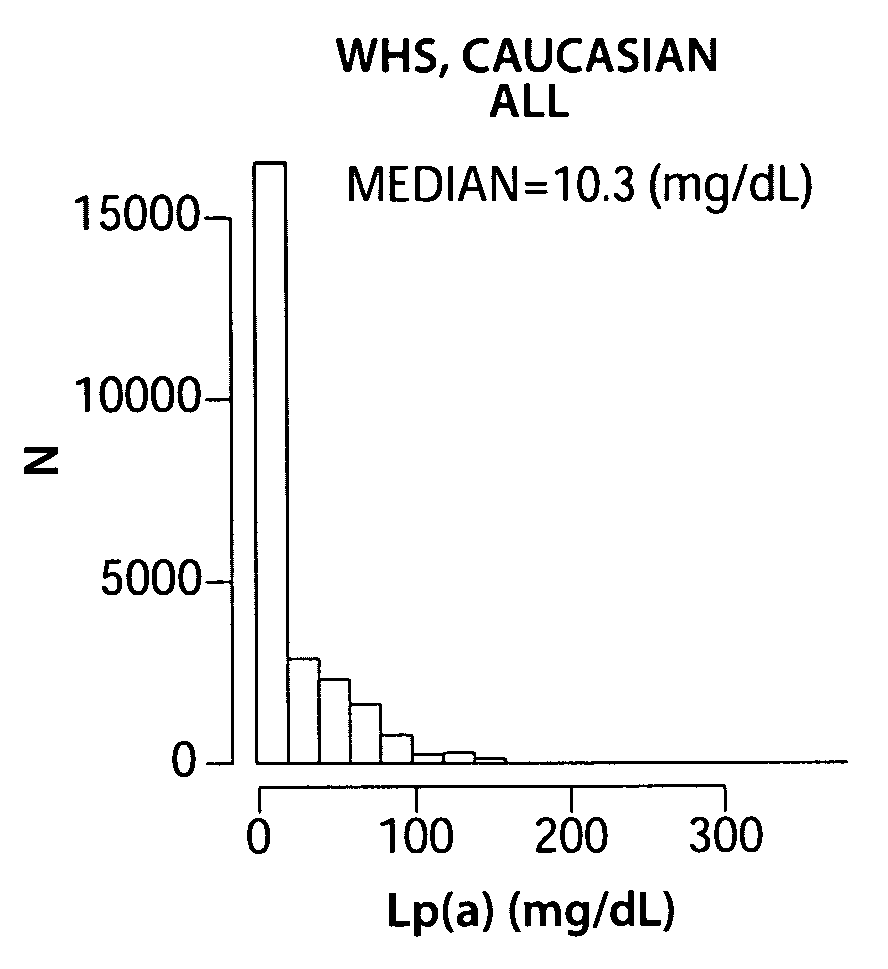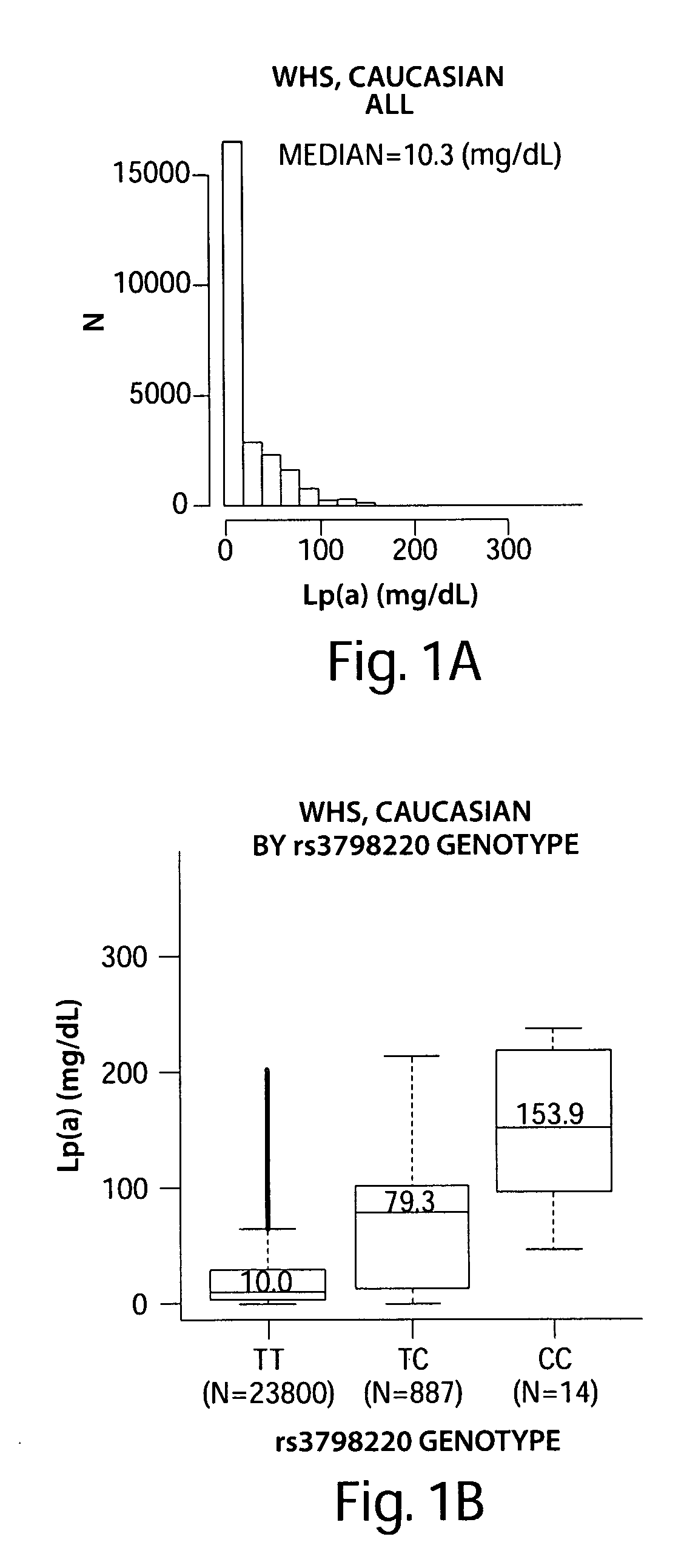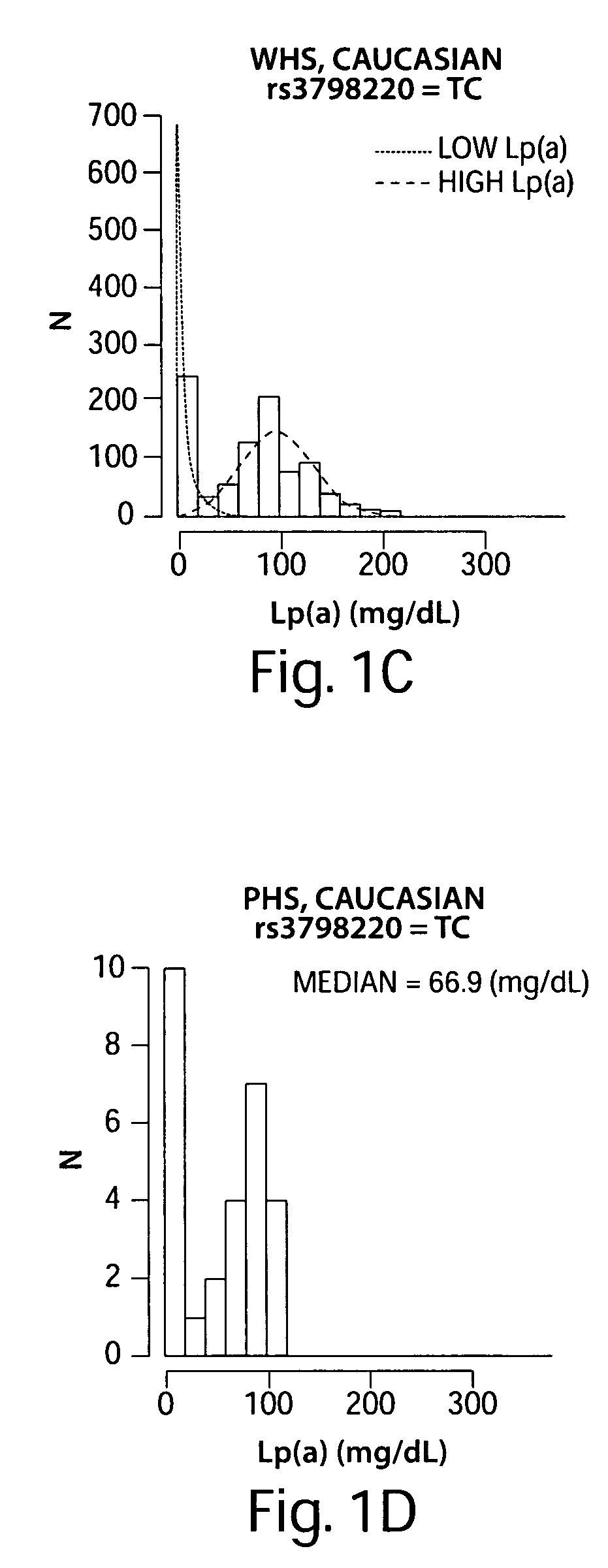Polymorphism in the apo(a) gene predict responsiveness to acetylsalicylic acid treatment (ridker)
a technology of acetylsalicylic acid and polymorphisms, which is applied in the field of polymorphisms in the apo (a) gene to predict the responsiveness of acetylsalicylic acid treatment, can solve the problems that acetylsalicylic acid is not effective in all subjects, and achieve the effect of reducing lowering the risk of a future cardiovascular even
- Summary
- Abstract
- Description
- Claims
- Application Information
AI Technical Summary
Benefits of technology
Problems solved by technology
Method used
Image
Examples
example 1
[0119]Lipoprotein(a) [Lp(a)] is a plasma fraction that consists of a single (Apo(a)) molecule covalently linked through a disulfide bond to a single apolipoprotein B-100 molecule together with cholesterol-rich lipid (1). While the biological functions of Lp(a) remain uncertain (2, 3), high levels of Lp(a) have been associated with increased cardiovascular (CV) risk, particularly when LDL-C is also elevated (4-6). The cholesterol-bearing aspects of Lp(a) have largely focused investigation of associated cardiovascular risk on lipid-based biology (7-11). However, apolipoprotein(a) is also highly homologous to plasminogen, and in spite of a lack of recognized proteolytic activity in apolipoprotein(a), this homology has focused alternative investigations of cardiovascular risk on roles of Lp(a) in hemostasis, platelet function, and thrombosis (12-18).
[0120]The apolipoprotein(a) locus is among the most polymorphic in the human genome. Apolipoprotein(a) genetic variation has been associate...
example 2
Genotyping of 40 Additional SNPs at and Near the LPA Locus in WHS Samples to Determine SNP Variation in LD with rs3798220 in European-Americans, Asian-Americans, and American Hispanics
[0192]We genotyped 40 additional SNPs at LPA (the gene for apolipoprotein (a)) and neighboring loci in a subset of samples from the WHS chosen on the basis of both rs3798220 genotype and self-reported ancestry (European-American (i.e., White or Caucasian), Asian-American, or American Hispanic). We then estimated linkage disequilibrium (LD) between these new SNPs and rs378220. Because the samples were not chosen at random but instead on the basis of rs3798220 genotype, we could not simply estimate allele frequency and LD from the sample directly but had to infer allele frequencies and LD by minimizing the difference between the observed and predicted genotypes given the rs379220-based sampling strategies. The results showed that:
[0193]1) two SNPs (rs9457931 dbSNP@NCBI (single nucleotide polymorphism at ...
example 3
Relationship Between rs3798220 Genotype, Number of Kringle IV Type 2 Repeats and Lp(a) Expression in Three Sub-Groups from the Dallas Heart Study with Distinct Ancestry
[0196]We had rs3798220 genotyped in Dallas Heart Study (DHS) (The American Journal of Cardiology Volume 93, Issue 12, 15 Jun. 2004, Pages 1473-1480) for which the number of Kr IV, type 2 repeats (KrIV2r's) in the apolipoprotein(a) component of plasma Lp(a) (i.e. expressed apop(a) protein) had been determined previously (Circulation. 2005; 111:1471-1479). This population includes both men and women, among non-Hispanic Whites (European ancestry), Blacks (African ancestry), and Hispanics, totaling 3529 samples. The analysis sought to identify a correspondence between the minor allele of rs3798220 and the number of expressed KrIV2r's, with possible dependence on ancestry. The analysis was performed the analysis two ways. In the first, all individuals were considered, and each individual's KrIV2r alleles (at the DNA level)...
PUM
| Property | Measurement | Unit |
|---|---|---|
| diastolic pressure | aaaaa | aaaaa |
| diastolic pressure | aaaaa | aaaaa |
| diastolic pressure | aaaaa | aaaaa |
Abstract
Description
Claims
Application Information
 Login to View More
Login to View More - R&D
- Intellectual Property
- Life Sciences
- Materials
- Tech Scout
- Unparalleled Data Quality
- Higher Quality Content
- 60% Fewer Hallucinations
Browse by: Latest US Patents, China's latest patents, Technical Efficacy Thesaurus, Application Domain, Technology Topic, Popular Technical Reports.
© 2025 PatSnap. All rights reserved.Legal|Privacy policy|Modern Slavery Act Transparency Statement|Sitemap|About US| Contact US: help@patsnap.com



